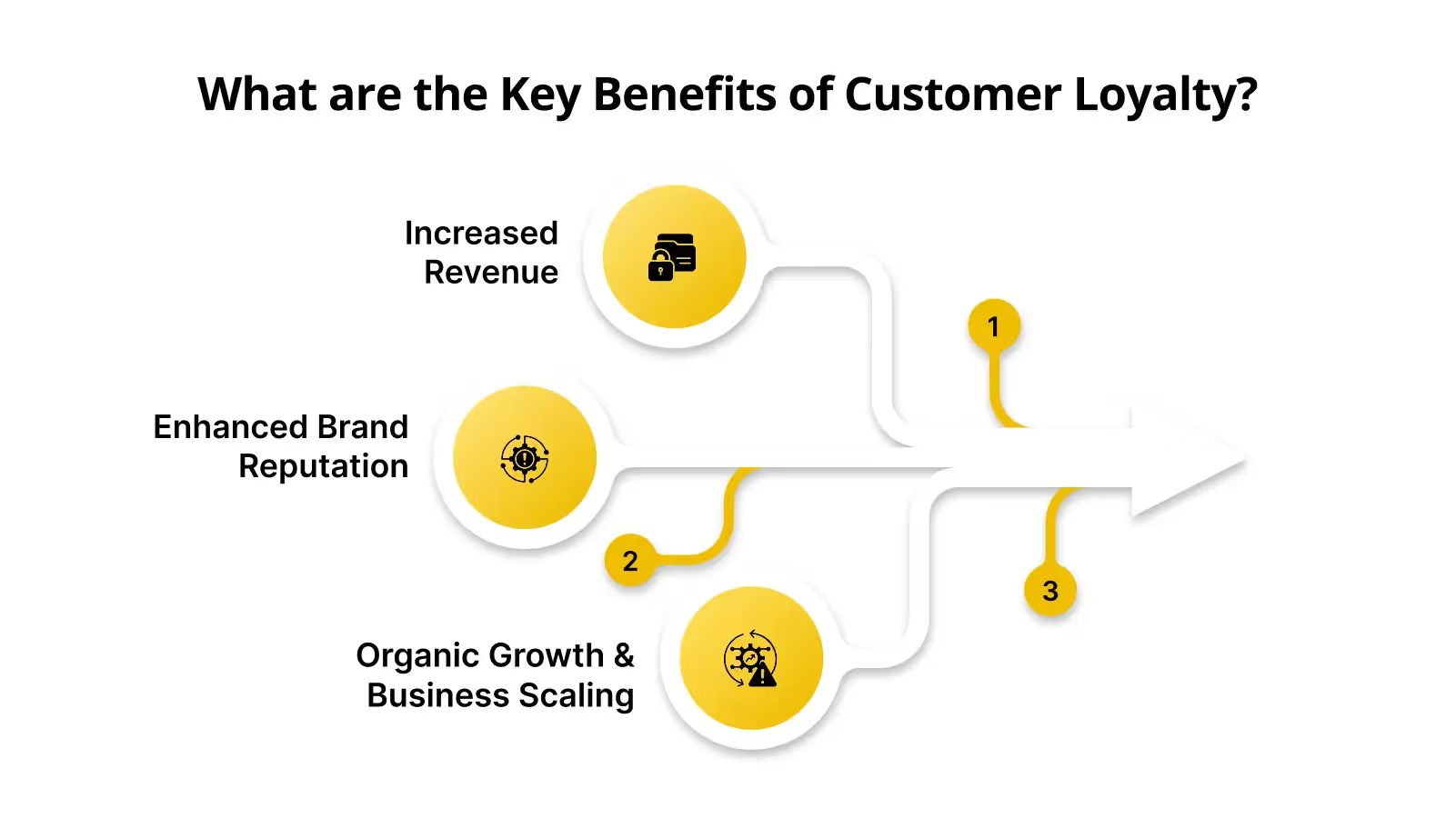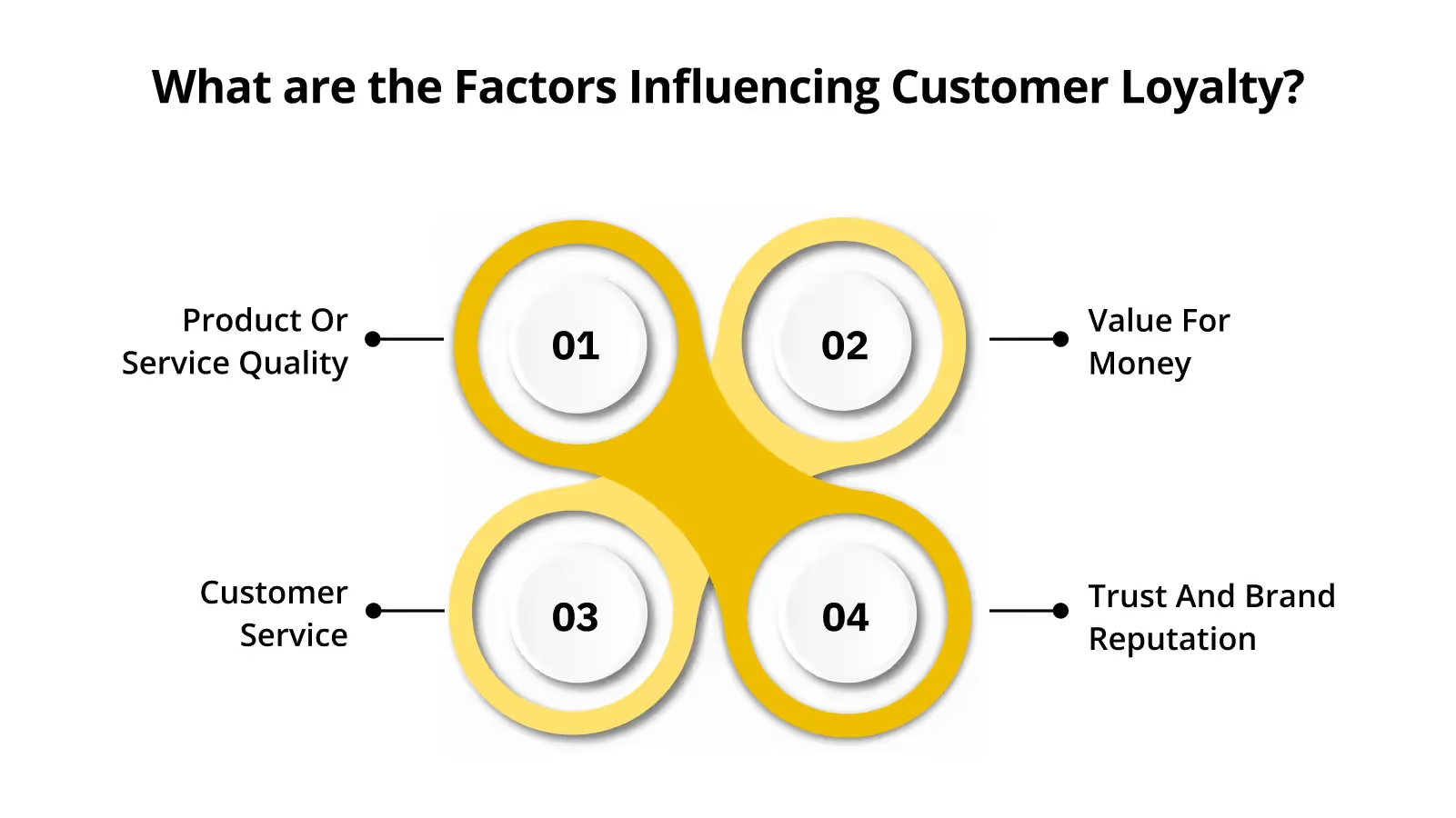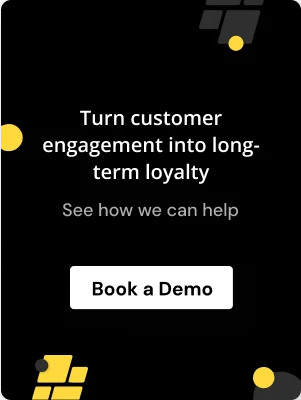.avif)
.avif)
For small businesses, customer loyalty is the cornerstone of lasting success. In a competitive market, loyal customers not only make repeat purchases but also reduce marketing costs and and act as your strongest advocates. Keeping your current customers is also much more affordable than chasing new ones all the time, and loyal customers often spend more, driving sustainable growth.
This growing emphasis on loyalty is backed by numbers. The global loyalty management market is set to grow to USD 20.44 billion by 2030, growing at a CAGR of 8.7%. Clearly, businesses worldwide are recognizing the immense value of building strong, lasting customer relationships.
In this article, we’ll explore actionable strategies for small businesses to cultivate strong customer loyalty, reduce churn, maximize Customer Lifetime Value (CLV), and build a robust foundation for long-term success.
At a Glance:
- Customer loyalty is essential for small business success, as retaining existing customers is much more affordable than chasing new ones all the time.
- Personalizing customer experiences by tailoring communications and offering strengthened connections creates long-lasting loyalty and repeat purchases.
- Great customer service delivers trust and keeps people coming back, turning them into loyal supporters of your brand.
- Loyalty programs with valuable rewards give customers an incentive to return, increasing engagement and ensuring repeat business.
- Measuring metrics like Customer Lifetime Value (CLV) and Net Promoter Score (NPS) helps track retention strategy effectiveness and refine it over time.
What is Customer Loyalty for Small Businesses?
Customer loyalty means people keep coming back to your brand instead of switching to competitors. Trust, positive experiences, and satisfaction drive it. For small businesses, building this loyalty can lead to repeat purchases, referrals, and organic growth.
A loyal customer base drives success by returning for more and spreading the word to others. This creates a snowball effect that drives business without the heavy costs of new customer acquisition.
Types of Loyalty: Emotional, Transactional, and Brand Loyalty
There are three types of customer loyalty:
- Emotional Loyalty: Built on trust and shared values, creating a deep connection.
- Transactional Loyalty: Driven by rewards and incentives for repeat purchases.
- Brand Loyalty: A mix of both emotional and transactional loyalty, leading to long-term support.
What are the Key Benefits of Customer Loyalty?

Customer loyalty provides more than just repeat purchases. It helps businesses improve profit margins, lower customer acquisition costs, and create a sustainable growth engine. Here are the primary benefits of nurturing customer loyalty:
1. Increased Revenue and Reduced Acquisition Costs
Loyal customers significantly boost revenue by making frequent purchases and spending more over time. Moreover, retaining these customers is far less expensive than constantly acquiring new ones, reducing marketing expenses and enhancing overall profitability for small businesses.
2. Enhanced Brand Reputation
Loyal customers act as brand ambassadors, sharing positive experiences with others. Their word-of-mouth recommendations, online reviews, and referrals help build a solid reputation, which is essential for small businesses striving to increase visibility and gain trust in a competitive market.
3. Organic Growth and Business Scaling
Loyal customers drive organic growth by returning for additional purchases and referring friends or family to your business. This type of growth not only reduces marketing costs but also helps scale operations without heavy investments in customer acquisition strategies, ensuring long-term success.
While these benefits highlight why loyalty matters, it’s equally important to understand the factors that influence it and shape how customers choose to stay connected with a business.
What are the Factors Influencing Customer Loyalty?

The foundation of customer loyalty lies in various key factors that drive engagement and customer retention. Understanding and mastering these elements helps businesses build a stronger connection with customers and encourage long-term loyalty.
1. Product or Service Quality
Consistent product or service quality is a cornerstone of customer loyalty. Small businesses that ensure their offerings meet or exceed expectations build reliability, trust, and credibility, leading to satisfied customers.
2. Value for Money
Customers are increasingly discerning about where they spend their money. Small businesses that offer high-quality products at competitive prices generate strong loyalty by providing real value. Delivering genuine value makes customers confident in buying again.
3. Customer Service
Responsive, empathetic customer service goes beyond resolving issues. It creates an emotional connection that drives loyalty. Being transparent and providing helpful service not only addresses immediate needs but also fosters long-term relationships, making customers feel valued and cared for.
4. Trust and Brand Reputation
Trust is an essential factor for customer loyalty. When small businesses maintain honesty, transparency, and reliability in their operations, it establishes a positive reputation. Consistently living up to brand promises helps develop trust, making it easier to retain and engage customers over time.
Also Read: A Practical Guide to Effective Customer Retention Management
10 Best Ways to Nurture Customer Loyalty

Repeat buyers form the backbone of small and new businesses aiming for lasting success. By focusing on personalized experiences, consistent service, and strong communication, you can build lasting relationships with customers. Below are the top ten ways to effectively nurture loyalty and grow your business.
1. Personalize Customer Experiences
Generic, one-size-fits-all interactions fail to foster a deeper relationship with customers. When experiences are personalized, customers feel recognized and appreciated, which is key to building lasting loyalty.
How Personalization Nurtures Loyalty:
- Utilize customer data to tailor product recommendations, making each interaction feel relevant and valuable.
- Send personalized email campaigns that reflect the customer's preferences or past purchases, ensuring your messages stand out.
- Use browsing history and preferences to display products that align with the customer’s taste, offering a customized shopping experience.
2. Create Seamless, Positive Customer Experiences
Any disruption or friction in the customer journey can lead to frustration, pushing customers away. A seamless experience increases the chances of repeat business.
How Seamless Experiences Build Loyalty:
- A speedy website and streamlined checkout keep customers from dropping off.
- Implement consistency across all channels, ensuring that whether a customer engages online, in-store, or via customer support, the experience remains smooth.
- Integrate automated personalization into the customer journey, so they feel consistently engaged, whether it’s an email or a follow-up message.
3. Offer Exclusive Rewards and Benefits
Nowadays, 61% of customers believe rewards programs are a key factor in driving repeat business with a brand or company. However, generic discounts no longer build loyalty. Rewards and benefits need to feel exclusive and tailored to motivate customers to return.
How Exclusive Rewards Drive Loyalty:
- Design loyalty programs from a platform like Nector that offer rewards based on purchase history or engagement behavior to make them feel more meaningful.
- Gamify rewards. Create levels or milestones (e.g., Silver, Gold) that motivate customers to stay engaged and feel a sense of achievement.
- Give your loyal customers a little extra love, like early access to new product launches or VIP-only promotions, reinforcing their value to the brand.
4. Prioritize Excellent Customer Service
Poor customer service can turn a loyal customer into a lost one. Exceptional service is vital in creating trust and retaining customers.
How Excellent Service Enhances Loyalty:
- Empower your team with tools to respond quickly and effectively, ensuring issues are resolved on the first interaction.
- Be proactive. Anticipate common customer issues and address them before they become problems.
- Train staff to go beyond expectations; provide personalized solutions that leave a lasting positive impression.
5. Build Emotional Connections with Customers
When customers don’t feel emotionally connected to a brand, they see it as just another transactional relationship, making them more likely to leave.
How Emotional Connections Foster Loyalty:
- Share authentic stories about your brand’s journey, values, or social causes that resonate with customers on an emotional level.
- Celebrate special moments with customers, like birthdays or anniversaries, with personalized messages or target rewards.
- Align your brand with the values that matter most to your audience, creating a deeper sense of connection that goes beyond just products.
6. Be Transparent and Consistent
Inconsistent quality or unclear communication can undermine trust and drive customers away. Transparency builds credibility and strengthens loyalty.
How Consistency Builds Loyalty:
- Communicate openly about any changes in product, pricing, or service. Let customers know what’s happening and why it matters to them.
- Maintain consistency in your offerings, whether it’s product quality, pricing, or customer service, so customers know what to expect every time.
- Keep your brand voice the same everywhere, on your site, socials, and even in customer support.
Also Read: Loyalty Points Program: How It Works
7. Engage Through Targeted Communication
Overwhelming customers with generic communication can feel intrusive. To engage effectively, you need to be relevant and timely.
How Targeted Communication Drives Loyalty:
- Use customer data to segment your audience and send tailored communications based on specific behaviors, like abandoned carts or previous purchases.
- Send timely follow-ups with personalized offers, reminding customers about products they’ve shown interest in or offering them incentives to return.
- Automate personalized messages that are triggered by customer actions, making every communication feel like it’s been crafted just for them.
8. Solicit and Act on Customer Feedback
Brushing off customer feedback can push them away and hurt engagement. Customers want to know that their voices are heard and that their input leads to tangible changes.
How Feedback Nurtures Loyalty:
- Regularly collect feedback through surveys or reviews to really get what customers want and spot where you can do better.
- Act on feedback by making changes that directly respond to customer concerns or suggestions. This shows your commitment to their satisfaction.
- A simple follow-up after feedback, highlighting the changes made, shows customers their voices truly matter.
9. Create a Community Around Your Brand
Customers who feel a part of a brand's community are more likely to stay loyal. Building a sense of belonging fosters emotional connections and strengthens brand loyalty.
How Community Engagement Builds Loyalty:
- Foster online communities (social media groups or forums) where customers can connect, share experiences, and advocate for the brand.
- Host events (virtual or in-person) to make customers feel more involved and valued as part of your brand's journey.
- Engage customers with exclusive content, behind-the-scenes looks, and brand updates to keep them invested in your brand's story.
10. Provide Consistent and Meaningful Value
People stick with brands that keep giving them real value, time after time. This is not just valid for the products or services offered but also through educational resources, expert insights, or practical tools.
How Value Creation Nurtures Loyalty:
- Offer helpful resources like blog posts, webinars, or tutorials that align with your customers' needs and challenges.
- Regularly update your customers on how your products or services continue to provide value or improve over time.
- Introduce educational content that empowers customers, enhancing their experience and positioning your brand as an expert in your field.
Building customer loyalty doesn’t happen overnight, but consistent effort pays off. By focusing on genuine value, trust, and meaningful engagement, small businesses can turn one-time buyers into long-term advocates who drive sustainable growth.
How Do You Measure Success in Customer Loyalty?

To ensure your customer loyalty strategies are effective, it’s essential to track the right metrics. Doing so can help you understand the impact of your efforts and spot areas for improvement. Here are a few metrics you can you to measure loyalty:
- Customer Retention Rate: This refers to the percentage of customers who continue to make repeat purchases. It reflects how well your business is building lasting relationships, keeping customers satisfied and engaged over time.
- Customer Lifetime Value (CLV): CLV refers to the cumulative value a customer contributes to a business throughout their relationship. It’s a useful metric for understanding the long-term potential of each customer, guiding decisions on customer acquisition and retention.
- Churn Rate: Churn rate shows how many customers drop off or stop buying from your business within a certain time frame. A high churn rate suggests a need to improve your offerings or customer service to keep people engaged and reduce attrition.
- Net Promoter Score (NPS): NPS tells you how happy your customers are and whether they’d actually recommend your brand to others. It’s a simple yet powerful way to measure overall loyalty and identify areas for improvement in the customer experience.
- Engagement Metrics: These metrics track how your customers interact with your brand, from email open rates to social media engagement. Monitoring these helps you refine your communication strategies and ensures your messaging is resonating with your audience.

What are the Challenges in Nurturing Customer Loyalty?

While nurturing customer loyalty is important for long-term growth, small businesses face common challenges that can undermine their efforts. Spotting and fixing problems early helps keep your strategies working smoothly for the long run.
1. Over-Automation Risks
While automation helps scale engagement, over-relying on it can cause a loss of personal touch, which is essential for genuine relationships with your customers.
How to Fix It:
- Use automation for routine tasks, but personalize key interactions
- Add customer names and specific recommendations in automated messages
- Limit the frequency of automated messages, especially at critical touchpoints
2. Integration Issues
Small businesses often face difficulty when integrating loyalty programs with their existing CRM or e-commerce platforms. Poor integration can create data silos and lead to inconsistent customer experiences.
How to Fix It:
- Always opt for tools like Nector that come with easy integration options
- Test integrations thoroughly before full deployment
- Centralize customer data to ensure a seamless experience.
3. Data Privacy and Security
As customer data becomes more essential for personalization, keeping it safe and following rules like GDPR is a must. Failing to do so can break the trust of your customers.
How to Fix It:
- Use data encryption for storage and transmission
- Regularly audit for compliance with data protection laws
- Obtain clear consent and allow customers to manage their data preferences
Also Read: Using Gamification to Enhance Referral Programs
Power Up Customer Loyalty with Nector’s Gamified Rewards
Transform your customer loyalty strategy with Nector’s dynamic rewards system. Our gamification features turn every purchase and interaction into a rewarding experience, keeping customers engaged and coming back for more.
Whether it's tiered loyalty levels or milestone-based rewards, Nector automates these processes to create personalized, meaningful incentives that boost retention and increase Customer Lifetime Value (CLV).
You can nurture lasting relationships by offering customers rewards they’ll value, all while simplifying management with Nector’s intuitive platform. Sign up today!
Wrapping Up
Building and nurturing customer loyalty requires a strategic, consistent approach. By focusing on personalized experiences, great customer service, and transparent communication, small businesses can cultivate strong, long-lasting relationships that provide long-term value.
Loyal customers are not just repeat buyers; they are the foundation for your business's growth, reputation, and success. Put these strategies into action, and you’ll start building a loyal customer base that keeps your business growing year after year.
For an even smoother customer experience, try Nector, which not only helps with building exciting loyalty programs but also offers smoother integration options. Book a demo now to learn how it works!

FAQs
What's the most effective way to boost customer loyalty?
The best approach to strengthening customer loyalty is by offering personalized experiences, consistent communication, and high-quality service. Loyalty programs, exclusive rewards, and emotional connections go a long way in keeping customers loyal over time.
What are the best strategies for building customer loyalty?
The best strategies for building customer loyalty include personalizing customer experiences, providing exceptional service, offering rewards programs, engaging through targeted communication, and continuously asking for feedback to improve your offerings and customer relationships.
What are the 3 R's of customer loyalty?
The 3 R's of customer loyalty are Recognition, Reward, and Retention. Recognizing customers for their loyalty, rewarding them for continued engagement, and focusing on retaining them through consistent value and service are essential to building strong loyalty.
Start Building Customer Retention That Lasts






.webp)



